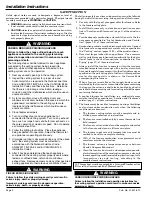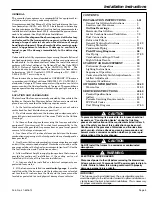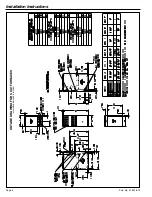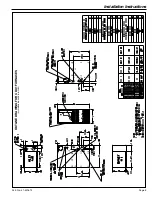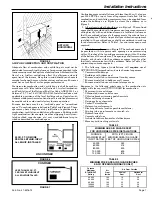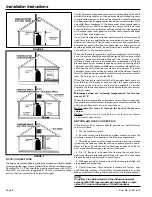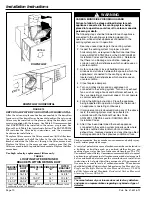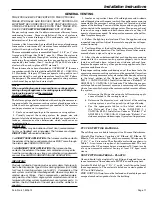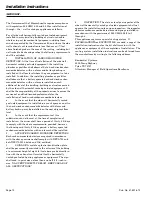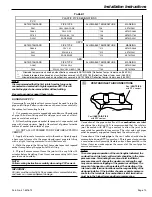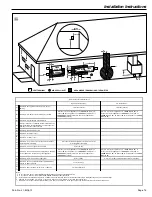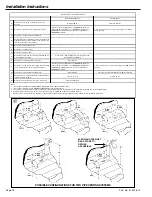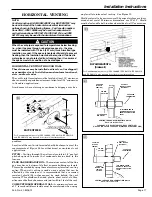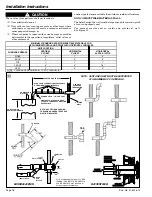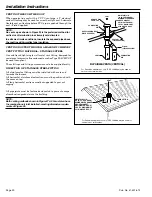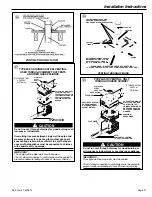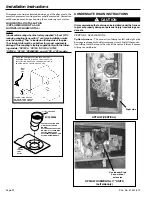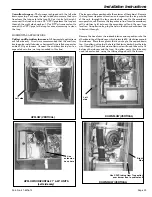
Installation Instructions
Pub. No. 41-5016-12
Page 8
DUCT CONNECTIONS
Air duct systems should be installed in accordance with standards
for air conditioning systems, National Fire Protection Association
Pamphlet No. 90. They should be sized in accordance with ACCA
Manual D or whichever is applicable. Check on controls to make
certain they are correct for the electrical supply.
FIGURE 9
Central furnaces, when used in connection with cooling units, shall
be installed in parallel or on the upstream side of the cooling units
to avoid condensation in the heating element, unless the furnace
has been specifically approved for downstream installation. With
a parallel flow arrangement, the dampers or other means used to
control flow of air shall be adequate to prevent chilled air from
entering the furnace, and if manually operated, must be equipped
with means to prevent operation of either unit unless the damper
is in full heat or cool position.
On any job, flexible connections of nonflammable material may be
used for return air and discharge connections to prevent trans-
mission of vibration. Though these units have been specifically
designed for quiet, vibration free operation, air ducts can act as
sounding boards and could, if poorly installed, amplify the slight-
est vibration to the annoyance level.
When the furnace is located in a utility room adjacent to the living
area, the system should be carefully designed with returns which
minimize noise transmission through the return air grille.
Although these winter air conditioners are designed with large
blowers operating at moderate speeds, any blower moving a high
volume of air will produce audible noise which could be objection-
able when the unit is located very close to a living area. It is often
advisable to route the return air ducts under the floor or through
the attic. Such design permits the installation of air return remote
from the living area (i.e. central hall).
When the furnace is installed so that the supply ducts carry air
circulated by the furnace to areas outside the space containing
the furnace, the return air shall also be handled by a duct(s)
sealed to the furnace and terminating outside the space contain-
ing the furnace.
Minimum return air “entering temperature” for the fur-
nace is 55° F.
Where there is no complete return duct system, the return connec-
tion must be run full size from the furnace to a location outside the
utility room, basement, attic, or crawl space.
Do Not install return air through the back of the furnace
cabinet.
Do Not
install return air through the side of the furnace cabinet
on horizontal applications.
RETURN AIR DUCT CONNECTION
All return air duct systems should provide for installation of
return air filters.
1. Set the furnace in place.
2. For side return installations on upflow models, remove the
insulation around the opening in the blower compartment.
3. The side panels on upflow furnaces include locating notches
which may be used as guides for cutting an opening for return air.
Refer to Figure 10 and the outline drawings on pages 4 and 5 for
duct connection dimensions for various furnaces.
4. If a 3/4" flange is to be used for attaching the air inlet duct,
add to cut where indicated by solid lines in Figure 10. Cut corners
diagonally and bend outward to form flange.
5. If flanges are not required, and a filter frame is installed, cut
along knockout guidelines.
6. Upflow furnaces: filter retainer brackets are factory sup-
plied for bottom return. Use the filter retainer brackets on either
side or on bottom if filter is to be used within the furnace cabinet.
NOTE:
On upflow 5 ton airflow models, if the airflow requirement
exceeds 1800 CFM, these models will require filters on both
sides; OR 1 side and the bottom; OR just the bottom.
FIGURE 8


